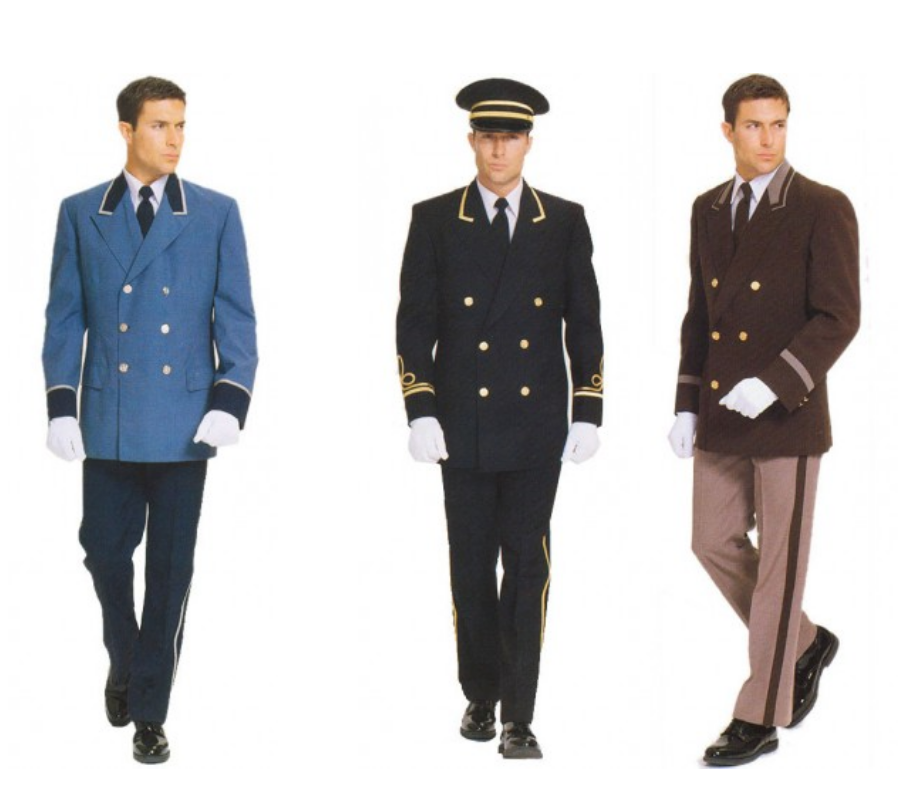According to the old admonishment, you shouldn’t judge a book by its cover and that’s sage advice in just about any situation; but when it comes to how your building and its on-site staff present themselves to residents, visitors, and prospective buyers, the ‘cover’ matters. You wouldn’t dream of using mismatched carpet samples and second-hand black-light posters to decorate your lobby, so it stands to reason that you wouldn’t be up for outfitting your front desk staff in jeans and ratty T-shirts.
Uniforms identify specific tasks and roles—a doorman, a super, a security guard, a concierge or a valet, and so on. Staff outfitted in clean, well-tailored uniforms project a professional image and can promote a sense of decorum and security that a non-uniformed staff may not. To the uninformed, outfitting the staff of a co-op or condo building may not seem like a large undertaking. Just order some pants, shirts, jackets and shiny shoes, right?
Not quite. Volume, storage, cleaning, maintenance and replacements are just the basic issues to be addressed when outfitting everyone from the doorman to porters, to maintenance and janitorial staff, and that’s before the questions of style, color and seasonal requirements even come into the picture.
Attract the Right Attention
Of course, what style of uniform you get depends a great deal not only on the amount of money your building has to spend on the project, but on the look or mood you’re trying to set for your building. A modest high-rise complex may be well-served by putting their doormen and security personnel in pressed trousers and crisp white shirts and ties with a basic navy blazer, while a historic or luxury building might go all-out, suiting their doorman in a wool greatcoat with gold buttons, braiding and epaulettes. Still other buildings might opt to put their front-of-house staff in smart black suits, to convey a mood of downtown hip and urbane suavity. In that regard, the uniformity of a building’s staff is as subjective as buildings are unique.
No matter the style, when a doorman or porter’s uniform is clean, neat and well fitting, it is easy to walk past and not really notice—and that may not be a bad thing. Jennifer Busch of Manhattan-based I. Buss & Allan Uniform Company® maintains it is better for uniformed staff to go unnoticed altogether than to be noticed for the wrong reasons.
According to Busch, “Image is an important part of our culture. A uniformed staff increases a building’s appeal.” When determining how to outfit a given client’s staff, Busch works with a board and its management to determine the style and image appropriate for the property. She looks at the building, the location, the lobby and the overall furnishings to help determine a complementary style for staff uniforms. “Old style, traditional, cutting edge—what image do you want to convey?” she asks a potential client.
Renting vs. Buying
Most uniform companies offer clients an option for both buying and renting uniforms. Renting includes cleaning and maintenance of uniforms and guarantees quality control. “We work with the staff, and provide one-stop shopping,” Busch explains. “If a client chooses to purchase the uniforms, separate cleaning agreements may be arranged.” Unionized buildings require staff uniforms to be furnished by the co-op corporation or condo association, so Busch rarely finds individuals responsible for purchasing their own work attire.
When a client has a rental agreement with the company, it is easier to address seasonal and weather changes. “How seasonal changes for uniforms are handled depends on the building,” Busch says. A client may choose lighter fabrics, short sleeves, and mesh hat inserts for warmer weather. “Some buildings may select a lighter jacket or vest or just a short sleeved shirt for the summer, but all items will be logo-ed. We have color and stripe options for polo shirts and cargo pants and we are able to create a cohesive image,” says Busch.
Once a style is agreed upon, it takes six to eight weeks for the made-to-measure uniform to be completed. Because of the turnaround time, a smart manager will be proactive, ordering winter uniforms in August, for example. Most uniform companies recommend ordering two sets per staff member to allow for a set being in the cleaners. Typical pricing for two doorman uniforms with ten shirts runs approximately $1,200, and roughly $1,500 for three complete sets—though the sky’s the limit, depending on budget, materials, and how ornate the building wants to get.
Respecting the Image
Alan Steinger of Top Hat Imagewear in Hempstead shares Busch’s views regarding the importance of image. Steinger took over ownership of the Long Island-based store in 1975. He had studied hospitality and hotel management, but soon found the business he grew up in fit him as well as a custom-tailored uniform. He started supplying tuxedos to restaurants, caterers, country clubs, casinos and hotels. Steinger moved from subcontractors to in-house manufacturing over 20 years ago and now has 85 employees manufacturing and shipping uniforms.
In order to determine uniform options for a property, uniform companies typically submit an array of choices to the board that complement and enhance the building itself, including seasonal uniform changes between winter and summer weights, as well as color changes. Once the design is selected, a company rep will go to a client building and take each staff member’s measurements to ensure comfort and proper fit. Overall, “Everyone should look like they shop at the same store,” says Steinger.
Both Steinger and Busch recommend that boards be proactive and order new or seasonal uniforms well before the weather starts to change. A short turnaround time usually means emergency rush pricing, so proactive planning will reduce the expense incurred when changes are needed or desired in a hurry.
One Size Does Not Fit All
While uniforms can identify and unify a staff and provide for image and branding, not all uniform requirements are the same, and not all budgets can embrace custom designs. Smaller buildings with smaller budgets still have an interest in maintaining a crisp, put-together staff, however—and for those communities, uniform rental rather than purchase may be a viable solution, says Jack Ippolito of Primo Uniform Services in Brooklyn.
For rental clients, Ippolito’s company offers uniform cleaning and repair services, and upon request will provide lockers to make weekly pickup and delivery easier. As with a purchasing customer, a company rep will make periodic on-site visits to measure all staff in order to obtain the best fit. “If a client employs three shifts, we measure all three,” Ippolito explains. They furnish uniforms for porters, mechanics, and painters, as well as doormen and concierge. “Uniforms identify the staff, and answer the question, ‘who are you letting in’?”
“Most service uniforms will last 2 to 4 years, and dress uniforms can last 4 to 6 years,” states Ippolito. He says that weekly cleaning improves the life span of the garments, but normal wear and tear often depends on the job. For example, “Plumbers tend to wear out the knees faster,” he explains.
Like Busch and Steinger, Ippolito prices out doormen uniforms in the $800-$1,200 dollar range, with wool overcoats being the most expensive item. He addresses seasonal requirements by sometimes splitting the orders.
Whatever the uniform requirements are for your condominium or co-op, there is a wide range of choices. A proactive board will shop early for the best pricing to meet the property’s needs. From stylish custom design to weekly rentals, there are options available for every taste and budget.



